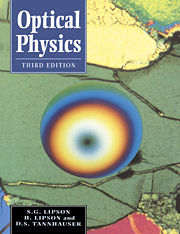Book contents
- Frontmatter
- Contents
- Preface to the third edition
- Preface to the second edition
- Preface to the first edition
- 1 History of ideas
- 2 Waves
- 3 Geometrical optics
- 4 Fourier theory
- 5 Electromagnetic waves
- 6 Polarization and anisotropic media
- 7 Diffraction
- 8 Fraunhofer diffraction and interference
- 9 Interferometry
- 10 Optical waveguides and modulated media
- 11 Coherence
- 12 Image formation
- 13 The classical theory of dispersion
- 14 Quantum optics and lasers
- 15 Problems
- Appendix 1 Bessel functions in wave optics
- Appendix 2 Lecture demonstrations in Fourier optics
- Bibliography
- Index
3 - Geometrical optics
- Frontmatter
- Contents
- Preface to the third edition
- Preface to the second edition
- Preface to the first edition
- 1 History of ideas
- 2 Waves
- 3 Geometrical optics
- 4 Fourier theory
- 5 Electromagnetic waves
- 6 Polarization and anisotropic media
- 7 Diffraction
- 8 Fraunhofer diffraction and interference
- 9 Interferometry
- 10 Optical waveguides and modulated media
- 11 Coherence
- 12 Image formation
- 13 The classical theory of dispersion
- 14 Quantum optics and lasers
- 15 Problems
- Appendix 1 Bessel functions in wave optics
- Appendix 2 Lecture demonstrations in Fourier optics
- Bibliography
- Index
Summary
Introduction
If this book were to follow historical order, the present chapter should have preceded the previous one, since lenses and mirrors were known and studied long before wave theory was understood. However, once we have grasped the elements of wave theory, it is much easier to appreciate the strengths and limitations of geometrical optics, so logically it is really more appropriate to put this chapter here. Essentially, geometrical optics, which considers light waves as rays which propagate along straight lines in uniform media and are related by Snell's law (§§2.7.2, 5.4.2) at interfaces, has a similar relationship to wave optics as classical mechanics does to quantum mechanics. For geometrical optics to be strictly true, it is important that the sizes of the elements we are dealing with be large compared with the wavelength λ. This means that we can neglect diffraction, which otherwise prevents the exact simultaneous specification of the positions and directions of rays on which geometrical optics is based. From the practical point of view, geometrical optics answers most questions about optical instruments extremely well and in a much simpler way than wave theory could do; it fails only in that it can not define the limits of performance such as resolving power, and does not work well for very small devices such as optical fibres. These will be dealt with by wave theory in Chapters 10 and 12.
The plan of the chapter is first to treat the classical ray theory of thin lens systems in the paraxial approximation.
- Type
- Chapter
- Information
- Optical Physics , pp. 37 - 70Publisher: Cambridge University PressPrint publication year: 1995



